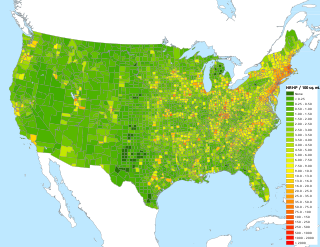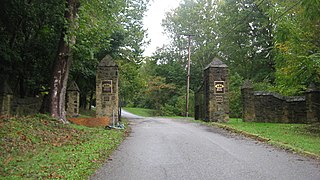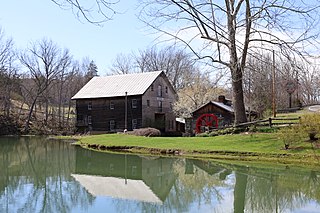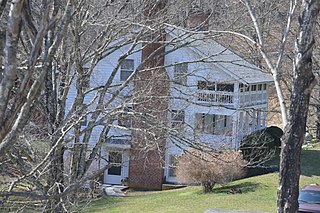
The National Register of Historic Places in the United States is a register including buildings, sites, structures, districts, and objects. The Register automatically includes all National Historic Landmarks as well as all historic areas administered by the U.S. National Park Service. Since its introduction in 1966, more than 90,000 separate listings have been added to the register.

The Shepherdstown Historic District comprises the historic core of Shepherdstown, West Virginia. The town is the oldest in West Virginia, founded in 1762 as Mecklenburg. No structures are known to exist from the time before the town became known as Shepherdstown. The historic district is concentrated along German Street, the main street, with 386 contributing resources and 69 non-contributing elements. The chief representative period is the late 18th century, with many Federal style brick houses. German Street is also furnished with 19th-century "street furniture" such as metal fences, mounting blocks, wooden pumps and mature trees.

Advance Mills, also known as Fray's Mill, is an unincorporated community in Albemarle County, Virginia.
Secondcreek is an unincorporated community in Monroe County, West Virginia, United States. Secondcreek is northeast of Union. The ZIP code for Secondcreek is 24974; however the post office was closed in 2010.

Muddy Creek Mill is a historic grist mill complex and national historic district located in Tamworth, Cumberland County, Virginia. The district encompasses five contributing buildings and three contributing sites. The mill was built between 1785 and 1792, and is a large two-story structure with two half stories and rests on a down slope basement. It is constructed of sandstone, rubble masonry, and brick. Associated with the mill are a contributing brick store, early-19th century frame miller's house, late-18th century farmhouse and dairy, and the sites of a cooper's shop, blacksmith's shop and saw mill.

Vancroft, also known as Mt. St. George Historic District, is a historic home and national historic district. It is located near Wellsburg, Brooke County, West Virginia. It encompasses 10 contributing buildings, one contributing structure, and one contributing object associated with the manor house. The manor house was designed by Alden & Harlow in 1901 for steel magnate Joseph B. Vandergrift. It is a Shingle Style dwelling with broad gable roofs, a rough stone turret, and stone chimney. Also on the property are a pergola, a club house or retreat house, spring house, race track, grotto, farm manager's house, two farm laborer's residences, mill, barn, and "the Apple House." The property was purchased by the Catholic Knights of St. George and operated as a home for the aged. In 1998, it was purchased by the Catholic Knights of America.

Jackson's Mill State 4-H Camp Historic District, also known as West Virginia University Jackson's Mill, is a historic 4-H camp and national historic district near Weston, Lewis County, West Virginia. The district includes 23 contributing buildings, 4 contributing sites, 4 contributing structures, and 2 contributing objects. The camp was established in 1921 as the first statewide 4-H camp in the United States. The district includes buildings related to the site's inception as a homestead and agricultural area as well as its current manifestation as a youth camp facility and conference center.
Nickell Homestead and Mill, also known as Mont Glenn Farm, is a historic home, grist mill, and national historic district located at Secondcreek, near Ronceverte, Monroe County, West Virginia. The district includes seven contributing buildings. The original section of the main house was built about 1820, with additions made in 1858, and about 1900. It is a 2+1⁄2-story, six bay brick and frame Federal style dwelling. The 1900 addition has some Colonial Revival style details. Also on the property is a two-story mill built in 1814, a barn, machine shed, hog shed, garage, and house by the mill. The Nickell mill closed in 1949. The property upon which the mill stood was sold in 2014 or 2015. The new owner tore down the mill. The only thing remaining is the stone foundation. The new owner is not maintaining the property and the house is also falling into disrepair. One wonders why this person bought an historic property only to destroy it.

Cook's Mill, also known as The Old Mill and The Greenville Mill, is a historic grist mill and sawmill and national historic district located near Greenville, Monroe County, West Virginia, United States. The district includes one contributing buildings and two contributing structures. The main mill building was built in 1857 on the original stone foundation and site of an earlier mill built in approximately 1796. It is a 2+1⁄2-story, plus basement, hand-hewn post-and-beam building, with massive timbers pegged at their mortise and tenon joints. The district also includes the dam, mill pond, tail race and stream.

Aldie Mill is a water mill in Aldie, Virginia. Built shortly after 1804 to grind grain using the waters of the Little River, it retains much of its original machinery and is one of the best-preserved mills in Virginia.

The Jervis Gordon Grist Mill Historic District, also known as the Milford Grist Mill and Rowe's Mill, is an historic grist mill and national historic district that are located in Milford, Pike County, Pennsylvania.

Dyerstown Historic District is a national historic district located in Dyerstown, Plumstead Township, Bucks County, Pennsylvania. The district includes 17 contributing buildings and 3 contributing structures in the crossroads village of Dyerstown. It is a largely residential district, with dwellings dating to the turn of the 19th century. The most recent dwelling was built about 1870. Some of the houses are reflective of vernacular Georgian style. The district also includes a former grist mill and associated outbuildings. The contributing structures are a stone arch bridge, and head race, dam, and remains of the mill race.

Galt's Mill Complex is a national historic district located near Madison Heights, Amherst County, Virginia. It encompasses 21 contributing buildings, 1 contributing site, 8 contributing structures, and 1 contributing object associated with a rural mill village. The buildings surround the masonry-constructed Galt's Mill, and are a variety of vernacular log or wood-frame structures. The mill was built in 1813, and is a two-story, brick structures. It was originally 5 1/5-stories, but lowered to its present height about 1950. The mill remained in operation until 1956. A store building was added about 1900. Other notable resources include the Aqueduct, Train Bridge, Railroad, Boathouse, Home House, Miller's House, and Millrace and Dam Ruins.

Brookside Farm and Mill is a historic grist mill and farm complex located at Independence, Grayson County, Virginia. The Brookside Mill was built in 1876, and is a three-story, three-bay by three bay, heavy timber frame building measuring 30 feet by 35 feet. The principal dwelling was built in 1877, and is a two-story, three-bay, frame building with a central passage plan. Other contributing buildings and structures include a brick spring house, brick smokehouse, log corn crib, frame hen house, miller's cabin, the miller's cottage or Graham House, a frame service station / garage (1918), and concrete dam (1914) and earthen mill race.

Village of Morattico Historic District is a national historic district located at Morattico, Lancaster County, Virginia. The district encompasses 69 contributing buildings, 1 contributing site, and 3 contributing structures in the village of Morattico. The district includes residential, commercial, and institutional buildings in a community whose economy was based on water-borne transportation, seafood extraction, and seafood processing. The village developed after 1890. Notable buildings include the Morattico General Store, Dr. Lewis' Office, Morattico Post Office (1949), Jackson Seafood (1950), Shelton Crab House, and Emmanuel United Methodist Church (1898).

Buckland Historic District is a national historic district located at Buckland, Prince William County, Virginia. It encompasses 30 contributing buildings, 11 contributing sites, and 6 contributing structures in the town of Buckland. The district is centered on a grist mill, Buckland Mill, the third such structure located on the site. Besides the mill, the most significant buildings include an early 19th-century wagon tavern and a small church. For the most part the houses are small, simple, 19th-century dwellings constructed of log, frame or stone; most were intended to serve a commercial as well as a residential purpose. Other contributing resources include the mill race and dam, Cerro Gordo plantation, portions of the Civil War Buckland battlefields, the Kinsley Mill and miller's house, and Buckland Hall.

White's Mill is a historic grist mill located near Abingdon, Washington County, Virginia. It dates to the mid-19th century, and is a frame two-story structure resting on a down slope basement with a full attic sheltered by a gable roof. It has a Fitz waterwheel and great gear wheel, buhr runs, roller mills, elevators and bolting machinery. Associated with the mill are the contributing earthen race which feeds directly into the wooden race and onto the wheel and an early coursed rubble limestone dam. The mill remains in working condition.

Alamance Mill Village Historic District is a national historic district located at Alamance, Alamance County, North Carolina. It encompasses 18 contributing buildings and 1 contributing structure built between 1840 and 1947 in Alamance. The district includes 15 mill houses, a warehouse, and the mill dam and connected remains of the head race.

Meek's Flour Mill is a historic building located in Bonaparte, Iowa, United States. William Meek and Dr. R.N. Cresap laid out the town of Meek's Mill in 1837. Although the town was renamed Bonaparte in 1841, the Meek family had a central role in its development through the turn of the 20th-century. The present building is a three-story, gable roofed, rectangular structure that was built on a raised basement of ashlar limestone blocks. It was constructed in 1878 by William's son Robert, who had succeeded his father in running the family businesses. He was assisted by his brothers Isaiah and Joseph. It replaced the original 1844 mill, which had been destroyed in a fire. While built on the same site, it is unknown if any part of the present structure was a part of the original mill. Two other structures belonging to the Meek's family are located nearby: a woolen mill (1853), and a saw mill (1860).

The Columbia Historic District is a neighborhood in Cedarburg, Wisconsin, that is listed on the National Register of Historic Places. At the time the district was listed on the register, its contributing properties included 128 historic homes, one church, and eighty-seven historic outbuildings, including garages and barns, all constructed between 1844 and 1938. The district also contained several dozen buildings that do not contribute to the historic district, including modern homes from the post-war era as well as modern garages and other additions to historic properties.






















